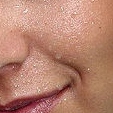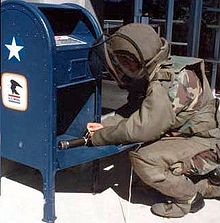Thermoregulation and Hydration
- Page ID
- 50857
Heat dissipation during physical activities, like exercise, is a critical part of thermoregulation. Humans have a basal (at rest)metabolic rate of about 0.63 W/kg, or roughly 50 W for the average person, where a watt (W) is one Joule per second. But exercising just certain groups of muscles may metabolize 0.090 g (0.5 mmol) of glucose per minute, producing 24 W of mechanical energy. Since muscle energy conversion is only 22-26% efficient, about 76 W of heat energy is produced at the same time.[1].

If this metabolic waste heat energy can't be dissipated, heat stroke or other consequences may result. Humans use perspiration from the skin as one means of thermoregulation, because it has a cooling effect due to the latent heat of evaporation of water. Animals with few sweat glands, like dogs, pant to achieve evaporative cooling through the tongue and mouth. Few other animals depend on sweating to cool down.
High humidity can reduce the rate at which the body can lose heat by evaporation. Light clothing that wicks sweat away but reflects radiant heat from the sun aids thermoregulation. plastic raincoats can actually contribute to heat stress. [3]
The volume of water lost in perspiration depends on exercise level, and ranges from 100 to 8,000 mL/day. [4]. Mild dehydration (at about 1% body mass loss) may impair cognition[5]. It's not hard to lose that much; a body mass loss of 3 to 5% can result from cycling without hydration (water intake) for 2 hours in Summer(35 °C). Other effects include loss of blood volume by 3 to 6%, increasing body temperature, higher heart rates, and poor blood circulation. These effects are easily eliminated by replacing 50 to 80% of the fluid lost in sweat[6]
Latent Enthalpy (Heat) of Vaporization
When perspiration is evaporated, a large amount of heat is absorbed even though the temperature remains constant at about skin temperature. The heat that is absorbed when perspiration evaporates (by breaking bonds between water molecules, thereby increasing its potential energy) is called the latent heat of vaporization. The kinetic energy of the water molecules (rotation, vibration, and limited translation) remains constant during phase changes, because the temperature does not change.
The heat of vaporization is usually recorded at the boiling point, but the heat absorbed by evaporating perspiration is similar, as suggested by the values in the table below.
When heat is supplied at a steady rate to a liquid at atmospheric pressure, the temperature rises until the boiling point is attained. After this the temperature remains constant until the enthalpy of vaporization has been supplied. Once all the liquid has been converted to vapor, the temperature again rises. In the case of water the molar enthalpy of vaporization is 40.67 kJ mol–1. In other words
\[\ce{H2O (l) -> H2O (g)} \nonumber\]
(100°C) ΔHm = 40.67 kJ mol–1
Example \(\PageIndex{1}\): Heat Dissipated in Exercise
How much perspiration must be evaporated if it is the only means of dissipating the 75 W of heat energy mentioned in the introduction, over a period of 30 minutes? Assume the heat of vaporization is about 43 kJ/mol at body temperature, and that no other heat loss (radiation and convection from the skin, etc.) is involved.
\[\text{30 min} \times \text{60} \dfrac{s}{min} \times \text{75} \dfrac{J}{s} = \text{135 kJ}\nonumber\]
This seems like a lot of energy! But how much perspiration would be evaporated?
\[\dfrac{\text{135 kJ}}{\text{43 kJ/mol}} = \text{3.1 mol or 57 g of water, about 2 oz}\nonumber\]
Latent Enthalpy (Heat) of Fusion
Protective gear worn by fire fighters, welders, and especially bomb disposal technicians may prevent evaporation of perspiration. The bomb suits worn to protect against Improvised Explosive Devices (IEDs) use an ice-based chiller unit and recirculating water to aid thermoregulation.[8] Only a small amount of ice is necessary, because it takes a large heat of fusion to melt ice, even though the temperature remains at 0 °C while the heat is absorbed.

The heat energy which a solid absorbs when it melts is called the enthalpy of fusion or heat of fusion and is usually quoted on a molar basis. (The word fusion means the same thing as “melting.”) When 1 mol of ice, for example, is melted, we find from experiment that 6.01 kJ are needed. The molar enthalpy of fusion of ice is thus +6.01 kJ mol–1, and we can write
\[\ce{H2O (s) -> H2O (l)} \nonumber\]
(0°C) ΔHm = 6.01 kJ mol–1
To remove the same amount of heat (135 kJ produced in 30 minutes) as the evaporation of 2 oz of perspiration, how much ice would be required?
\[\dfrac{\text{135 kJ}}{\text{6.01 kJ/mol}} \times \text{18 g/mol} = \text{404 g}\nonumber\]
(less than a pound) of ice.
Selected molar enthalpies of fusion are tabulated below. Solids like ice which have strong intermolecular forces have much higher values than those like CH4 with weak ones.
| Substance | Formula | ΔH(fusion) / kJ mol1 |
Melting Point / K | ΔH(vaporization) / kJ mol-1 | Boiling Point / K | (ΔHv/Tb) / JK-1 mol-1 |
|---|---|---|---|---|---|---|
| Neon | Ne | 0.33 | 24 | 1.80 | 27 | 67 |
| Oxygen | O2 | 0.44 | 54 | 6.82 | 90.2 | 76 |
| Methane | CH4 | 0.94 | 90.7 | 8.18 | 112 | 73 |
| Ethane | C2H6 | 2.85 | 90.0 | 14.72 | 184 | 80 |
| Chlorine | Cl2 | 6.40 | 172.2 | 20.41 | 239 | 85 |
| Carbon tetrachloride | CCl4 | 2.67 | 250.0 | 30.00 | 350 | 86 |
| Water* | H2O | 6.00678 at 0°C, 101kPa 6.354 at 81.6 °C, 2.50 MPa |
273.1 | 40.657 at 100 °C, 45.051 at 0 °C, 46.567 at -33 °C |
373.1 | 109 |
| n-Nonane | C9H20 | 19.3 | 353 | 40.5 | 491 | 82 |
| Mercury | Hg | 2.30 | 234 | 58.6 | 630 | 91 |
| Sodium | Na | 2.60 | 371 | 98 | 1158 | 85 |
| Aluminum | Al | 10.9 | 933 | 284 | 2600 | 109 |
| Lead | Pb | 4.77 | 601 | 178 | 2022 | 88 |
*http://www1.lsbu.ac.uk/water/data.html
Heat energy is absorbed when a liquid boils because molecules which are held together by mutual attraction in the liquid are jostled free of each other as the gas is formed. Such a separation requires energy. In general the energy needed differs from one liquid to another depending on the magnitude of the intermolecular forces. We can thus expect liquids with strong intermolecular forces to have larger enthalpies of vaporization. The list of enthalpies of vaporization given in the table bears this out.
Two other features of the table deserve mention. One is the fact that the enthalpy of vaporization of a substance is always higher than its enthalpy of fusion. When a solid melts, the molecules are not separated from each other to nearly the same extent as when a liquid boils. Second, there is a close correlation between the enthalpy of vaporization and the boiling point measured on the thermodynamic scale of temperature. Periodic trends in boiling point closely follow periodic trends in heat of vaporiation. If we divide the one by the other, we find that the result is often in the range of 75 to 90 J K–1 mol–1. To a first approximation therefore the enthalpy of vaporization of a liquid is proportional to the thermodynamic temperature at which the liquid boils. This interesting result is called Trouton’s rule. An equivalent rule does not hold for fusion. The energy required to melt a solid and the temperature at which this occurs depend on the structure of the crystal as well as on the magnitude of the intermolecular forces.
From ChemPRIME: 10.9: Enthalpy of Fusion and Enthalpy of Vaporization
Contributors and Attributions
Ed Vitz (Kutztown University), John W. Moore (UW-Madison), Justin Shorb (Hope College), Xavier Prat-Resina (University of Minnesota Rochester), Tim Wendorff, and Adam Hahn.


